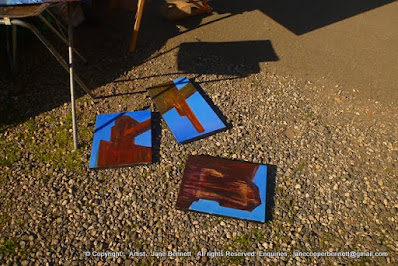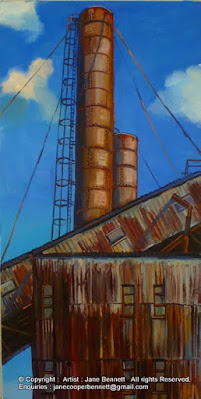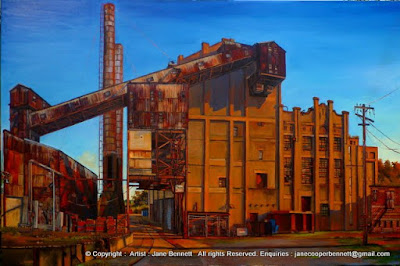- Possession of controlling influence ; having great influence or control over others
- (physics) the rate of doing work; measured in watts (= joules/second)
- Possession of the qualities (especially mental qualities) required to do something or get something done
- The ability or capacity to perform or act effectively.
- The ability or official capacity to exercise control; authority.
- Physical strength
- a prerogative, privilege, or liberty
- Forcefulness; effectiveness
- A specific capacity, faculty, or aptitude.
- to travel with great speed or force
- Of or relating to the generation or transmission of electricity
- Power (physics), the rate at which work is performed or energy is converted
- Electric power, the rate at which electrical energy is transferred by a circuit
- Human power, the rate of work performed by a human
- Motive power, an agent used to create motion
Definitions of 'power'
 |
WBPS85 ' White Bay Power Station' 2016 oil on canvas 61 x 91cmAvailable for sale |
11. 'Of or relating to the generation or transmission of electricity...'
.White Bay Power Station was originally built by the Department of Railways to supply more power for Sydney’s growing Electric Tramway System in 1912 (and was later expanded for the City and Suburban Railway Electrification in the mid 1920s)The power station was constructed in two stages. The first stage, built between 1912 and 1917, consisted of a boiler house, standing roughly where the present boiler house stands, and part of the turbine hall and switch house. The second stage, which commenced in 1925, saw the completion of the turbine hall and switch house.
After the Second World War, the first boiler house was demolished and, between 1950 and 1958, replaced in two stages with the present boiler house.
Demand for power from White Bay waned when the trams were abolished*. By the 1970s, the demand had diminished to such an extent that the second boiler house was pulled down and the turbines sold.
After the Second World War, the first boiler house was demolished and, between 1950 and 1958, replaced in two stages with the present boiler house.
Demand for power from White Bay waned when the trams were abolished*. By the 1970s, the demand had diminished to such an extent that the second boiler house was pulled down and the turbines sold.
 |
| WBPS83 'Coal Loader + Chimney White Bay Power Station' 2016 oil on paper 9.5 x 9.5cm Available for sale Enquiries about other White Bay Power Station paintings |
The power station was decommissioned on 25 December 1983.
In the late 1980s and early 1990s, the power station was gradually stripped, except for items identified for heritage conservation.
In August 2000, Pacific Power sold White Bay Power Station to Sydney Harbour Foreshore Authority.
*Ironically, Light rail is being re-established in the inner western suburbs so the demand for power is now increasing!
In the late 1980s and early 1990s, the power station was gradually stripped, except for items identified for heritage conservation.
In August 2000, Pacific Power sold White Bay Power Station to Sydney Harbour Foreshore Authority.
*Ironically, Light rail is being re-established in the inner western suburbs so the demand for power is now increasing!
 |
| Painting the White Bay Power Station "White Bay Power Station" 2011 oil on canvas 102 x 152cm Sold |
10.To travel with great speed or force...
I'm putting the final flourishes on my gigantic painting of the White Bay Power Station. It's been a race against time.
Even though my next solo exhibition "May close without warning" doesn't start until the 11th October, I had to get some strong images together for the advertising in the "Look" Magazine, and think about suitable images for the invitation. Most of my paintings of the Eveleigh Railway Workshops are just too dark to photograph well. So the pressure was on me to finish this work in time!
14.Human power-the rate of work performed by a human...
Many invitations show the artist posing self-consciously in front of works in progress in their pristine white studio. But I have no studio as such. Although, on the other hand as I work "en plein air" you could say that the whole world is my studio.
So just for a change, I thought I'd include a couple of images of my works in progress on location.
The security guard took a few photos of me in action completing this canvas, and my gallery dealer liked this one so much that we might even include it on the invitation to the opening!
I wear an Akubra, not a beret while I paint.
The Akubra hat is a necessity and not an artistic affectation. It shades my face from the sun, keeps my hair out of my eyes and is waterproof enough to keep the rain off in bad weather.
6.Physical strength...
 |
Putting the final details on the "White Bay Power Station" "White Bay Power Station" 2011 oil on canvas 102 x 152cm |
This canvas is 102 x 152cm - extremely large for a work painted outdoors on location. The early stages could be painted fairly quickly, but nuances such as light falling on the windows are made more difficult by the slightest puff of wind making the canvas beat like a drum.
I fossicked for bricks to weight down my easel so I wouldn't have to chase it all over the yard.
3.Possession of the qualities (especially mental qualities) required to do something or get something done...
The worst moment was painting the thin diagonal lines reaching from the top of the chimney stacks to the roof. I had been dreading putting these in, as they had to be painted in a single confident unbroken stroke, cutting across the sky. The sky was still wet, so I couldn't use a ruler.
I fossicked for bricks to weight down my easel so I wouldn't have to chase it all over the yard.
3.Possession of the qualities (especially mental qualities) required to do something or get something done...
The worst moment was painting the thin diagonal lines reaching from the top of the chimney stacks to the roof. I had been dreading putting these in, as they had to be painted in a single confident unbroken stroke, cutting across the sky. The sky was still wet, so I couldn't use a ruler.
 |
Using my car as a windbreak so I can add some details with a fine brush.
|
"White Bay Power Station"
2011 oil on canvas 102 x 152cm
Sold
4.The ability or capacity to perform or act effectively...
I tried to use my car as a windbreak, with only partial success. As you can see from the photo above, I adjusted the French box easel until the canvas was almost horizontal, but it was still too risky to paint these fragile lines. If I made the slightest mistake, I would have had to scrape down the entire sky and start again.
8.Forcefulness; Effectiveness
I waited a long time for a still, calm day before I had the confidence to tackle this task. Then a final decisive sweep of the brush and the canvas was finished.
2.The rate of doing work...
Meanwhile I completed a few small studies of details of the Power Station, partly to help me to understand the complexities of light and form, and partly to fill in time while waiting for the wind to drop so that I could finish the large canvas.
8.Forcefulness; Effectiveness
I waited a long time for a still, calm day before I had the confidence to tackle this task. Then a final decisive sweep of the brush and the canvas was finished.
2.The rate of doing work...
Meanwhile I completed a few small studies of details of the Power Station, partly to help me to understand the complexities of light and form, and partly to fill in time while waiting for the wind to drop so that I could finish the large canvas.
 |
| Works in progress |
 |
Painting the "White Bay Power Station stacks" 2011 oil on board 51.5 x 25cm |
 |
| "White Bay Power Station stacks" 2011 oil on board 51.5 x 25.5cm Available for sale |
 |
| "White Bay Power Station coal loader" 2011 oil on board 35 x 28cm Available for sale |
 |
The completed canvas "White Bay Power Station" 2011 oil on canvas 102 x 152cm Sold |





